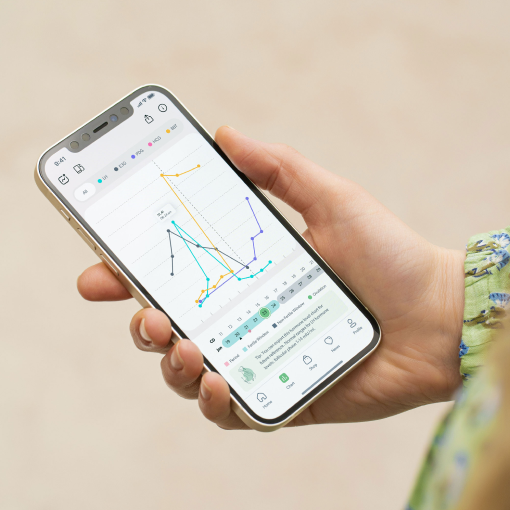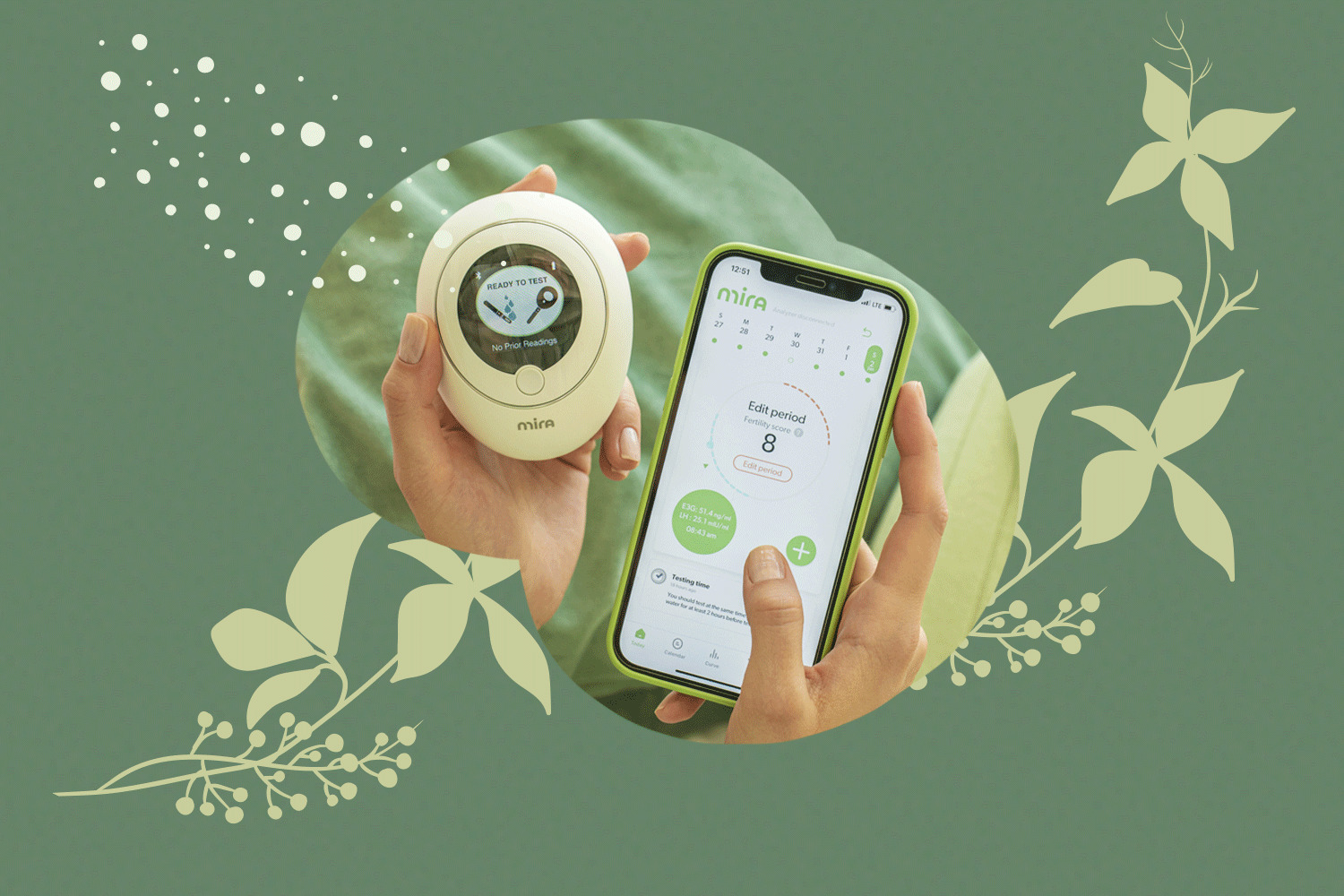Fertility Awareness Methods for Natural Family Planning
If you’re a woman, you’re probably familiar with the side effects of hormonal birth control, including potentially dangerous ones like major depression or blood clots.

Without birth control, women have a 15 to 25 percent chance of getting pregnant each month. What if you’re not willing to take that risk, yet don’t want to turn to hormonal methods for family planning?
Fertility awareness methods (FAMs) are a form of natural contraception. These natural fertility methods help you estimate your fertile window and avoid sex when you are most like to get pregnant, reducing your odds of unwanted pregnancy.
FAMs are almost 90% effective at preventing pregnancy when used consistently and correctly. Best of all, they are 100% hormone- and side-effect-free! But in order to avoid an unplanned pregnancy when using FAMs, you need to be well-informed about FAMs and your cycle.
Read on to learn everything you need to know about FAMs and how to follow each method.
What are fertility awareness methods (or FAMs)?
Fertility awareness methods (FAMs) are a form of natural family planning that involves getting to know your menstrual cycle and watching for common signs of fertility. You diligently track your body’s signs and symptoms, then use them to predict when you are most fertile so you can avoid sex during those times — or plan sex around your fertile window if you are trying to conceive.
FAMs can help you avoid pregnancy, but it’s important to note that they will not protect you against sexually transmitted infections (STIs). If you are having sex with multiple partners, you should still use a barrier method like a male or female condom to prevent STI transmission.
How to Use FAM Birth Control
For FAMs to effectively prevent pregnancy, you need to understand how they work and commit yourself to using them consistently. However, not every woman may feel comfortable using FAMs.
Who are they for?
FAMs work better for some women than others. Here’s how to tell if natural family planning is right for you.
You might use a FAM if…
- You want to avoid hormones. FAMs are a 100% hormone-free birth control method. If you prefer not to take hormones, or cannot take hormones due to a medical condition (for example, if you have a history of breast cancer), FAMs might be a good option for you.
- You want to get pregnant someday. Hormonal birth control cannot help you get pregnant. Some forms, like the pill, can impact your fertility for several months after stopping them. Getting in touch with your cycle using a FAM, regardless of whether you’re trying to get pregnant right now, can make it easier to pinpoint your fertile window when you’re ready to conceive.
- You don’t want side effects. Because FAMs do not require you to put any unnatural substance into your body, there are no side effects associated with FAMs. This is not the case for hormonal birth control methods, which come with a slew of side effects.
- You are having unprotected sex with one partner. FAMs alone do not protect against STIs, so they work best when you know you will not be exposed to an STI. When you are in a long-term relationship with one partner, and neither of you has ever had an STI, you may prefer to have unprotected sex. With FAMs, you can time sex with your least fertile times of the month so that you do not need to use a barrier method all the time.
- You don’t want to pay for a prescription. The costs associated with procedures like IUD insertion or monthly prescriptions for birth control pills can quickly add up. Alternatively, FAMs require very little financial commitment from you. You may want to make a one-time investment in a basal body temperature (BBT) thermometer or digital fertility tracker, but there are few long-term expenses associated with FAMs.
You might not use a FAM if…
- You don’t want to think about your birth control. FAMs require you to diligently track your menstrual cycle and associated symptoms. If you forget to track, you may make a mistake, resulting in an unexpected pregnancy. For women who would rather “set it and forget it,” long-acting reversible contraceptives (LARCs) like an intrauterine device (IUD) or implant might be better options.
- You don’t want to get a period. FAMs rely on your body’s natural rhythms, meaning that you should get your period as usual. Some women prefer a birth control method that lightens or halts their periods altogether. If this sounds like you, then you might prefer a hormonal birth control method like the pill or an IUD.
- You are managing hormonal health conditions. If you have a health condition involving reproductive hormones like estrogen or progesterone, your doctor might recommend that you use a hormonal birth control method to manage it. One example of this is endometriosis: hormonal birth control can help women with endo skip their periods and avoid unnecessary pain.
- You are having sex with multiple partners, or your partner has an STI. Women who are having sex with multiple partners should not rely on FAMs alone. While FAMs can effectively prevent pregnancy, they do not protect against STIs. The same goes if you are in a long-term relationship with someone who has an STI — for example, if your partner is HIV-positive. Using a barrier method will protect you from contracting an STI and from getting pregnant.
How can you make FAMs more successful?
One concern many women have about FAMs is that they are not as effective as hormonal birth control methods. When used correctly, FAMs have a 12% failure rate. This means they are about as effective as the pill, but much less effective than LARCs like the IUD or implant.
You can make FAMs more effective by combining multiple methods, such as the basal body temperature (BBT) method and the cervical mucus method, of tracking to more accurately pinpoint your fertile window.
You can also use a digital fertility tracker like Mira, which measures your exact fertility hormone concentrations with lab-grade accuracy. Mira is over 99% accurate at predicting your fertile window and can support you in successfully using FAMs to prevent pregnancy.
FAMs are most successful if you avoid having sex during your fertile window. You may think that if you do not use birth control, you will get pregnant — when in reality, women can only get pregnant a few days out of the month. By avoiding your most fertile days, you can still enjoy sex with your partner without worrying about an unplanned pregnancy.
Types of Natural Fertility Awareness Methods
Maybe you’re curious about practicing FAMs or have previously decided that a FAM is right for you. In that case, you’re probably ready to learn more about the different types of FAMs you can use to prevent pregnancy. Read on to learn about four common FAMs and how they are practiced.
1. Basal Body Temperature Method
BBT is your body’s resting temperature and the basal body temperature (BBT) method relies on measuring your BBT every morning before you get out of bed. Women have a small increase in BBT after ovulation. This happens when your body’s progesterone levels rise. Peak fertility days are typically two to three days before BBT increases. By detecting that increase in BBT, you can predict when you are most fertile and when you should avoid sex.
When to Use
If you are trying to get pregnant, the BBT method is a great option for pinpointing your most fertile days of the month.
The BBT method requires you to take your temperature first thing in the morning before you get out of bed. If you measure it after you have already moved, it may not be accurate. You should not use the BBT method if you do not want to or do not think you can remember to take your temperature each morning.
The BBT method also requires a special thermometer called a BBT thermometer. These thermometers can be pricey, so ensure that you are ready for the commitment before choosing the BBT method. It takes time to get used to the routine of using a BBT thermometer. You may need to use a barrier method for the first few cycles while you are getting the hang of tracking your BBT.
Tips
- Take your basal body temperature at the same time each day.
- Record your BBT using a charting app or graph paper.
- Perform the process daily for several cycles.
- Note patterns and avoid or have intercourse during your estimated fertile days, depending on whether you are trying to prevent or plan for pregnancy.
Pros
- Hormone-free and 100% natural
- Great for planning a pregnancy
- An accurate way of pinpointing ovulation
- Can be used by women with health or religious restrictions on birth control use
Cons
- Takes time to get used to tracking your BBT
- May require a backup method for the first few months
- The most accurate BBT thermometers are often expensive
- Does not protect against STIs
2. Cervical Mucus Method
The cervical mucus method, or the Billings ovulation method, monitors changes in cervical mucus to predict your most fertile days. Cervical mucus changes during ovulation when your body’s estrogen level rises, allowing sperm to survive in the vagina for the fertilization of an egg. Normally, your cervical mucus is thick, creamy, and white or yellow in color. During ovulation, however, it will become clear, stretchy, and slippery, much like the texture of an egg-white.
When to Use
If you want to understand your body better, the cervical mucus method will help you get to know your natural signs of fertility and understand the patterns of your cervical mucus throughout your cycle.
In order to check your cervical mucus each day, you will need to be comfortable inserting a finger into the vagina and locating the cervix inside the vagina. Your cervix is the donut-shaped passageway that connects your uterus to the vagina. Sperm passes through the cervix to get to an egg. The cervix changes positions throughout the menstrual cycle, becoming high, soft, and open during ovulation and low, hard, and closed during the rest of the month. As a result, it can take time to feel comfortable finding the cervix inside the vagina.
The cervical mucus method, like other FAMs, requires consistency. You must remember to check your cervical mucus every day and diligently avoid sex when you are most fertile. If you do not think you can be consistent, the cervical mucus method may not be right for you. It may take a few cycles to feel comfortable with the cervical mucus method. In the meantime, you may want to use a barrier method to prevent pregnancy while you are getting to know your cycle.
Tips
- Use a panty liner or toilet paper to collect mucus.
- Check manually using one or two fingers.
- Use the same method of collection every time.
- Make notes about color, consistency, and amount in a chart like the one above.
Pros
- Hormone-free and 100% natural
- Doesn’t cost anything
- Allows you to get to know your body’s natural rhythm
- Can be used by women with health or religious restrictions on birth control use
Cons
- Requires consistency
- May require a backup method for the first few months
- Can be difficult to locate the cervix in the vagina
- Not every woman is comfortable inserting a finger in her vagina to collect cervical mucus
- Does not protect against STIs
3. Calendar/Calculator Method
This FAM uses a calendar of your cycle or a cycle calculator to determine when you are most fertile so you can plan or avoid sex during those times. There are many ovulation calculator apps and cycle trackers with easy-to-read calendars that you can use to estimate your fertile window.
It follows a basic formula to estimate your fertile window and ovulation day and the formula is based on the first day of your last period and your typical cycle length. Many apps allow you to set up notifications to remind you when your fertile window is approaching.
When to Use
The calendar/calculator method is a quick and easy way to determine when you are most fertile. However, it may not be the most accurate way to detect your ovulation and fertile window. Many ovulation calculators make predictions based on the standard 28-day cycle when in reality, a normal menstrual cycle can range from 21 to 35 days in length.
Calculators rely on an average of your cycle lengths to predict when you are most likely to ovulate. The longer you track for, the more precise the predictions become — but it may take a year or more for those predictions to become truly accurate. In the meantime, you will need to use a backup method, such as a barrier, for preventing pregnancy.
Because of its large margin for error, the calendar/calculator method is a good way to track your cycle if you want to become pregnant or are “pregnancy-neutral” (i.e. neither trying to get pregnant or avoid getting pregnant). It may not be most appropriate if you are actively trying to avoid pregnancy.
Tips
- Use Mira’s fertility calculator to estimate your fertile window and ovulation.
- Or, download the free Mira App to start tracking your cycle — you do not need the Mira digital fertility analyzer to use our app (though it certainly helps)!
- Avoid or plan sex on your most fertile days, depending on whether you are trying to prevent pregnancy or conceive.
Pros
- Hormone-free and 100% natural
- Doesn’t cost anything
- Quick and easy to use
- No daily tracking of body temperature or cervical mucus required
- Can be used by women with health or religious restrictions on birth control use
Cons
- Takes a long time to make accurate predictions
- May require a backup method for the first few months
- Not the most accurate method of preventing pregnancy
- Does not protect against STIs

4. The Standard Days Method
The Standard Days Method is a calendar-based FAM that uses a fixed window in a woman’s menstrual cycle (days 8 through 19) to avoid sex if you do not want to get pregnant — or to plan sex if you are trying to conceive. This window may seem wide, but it accounts for the variation in ovulation days between women and between cycles.
All other days of the menstrual cycle are considered non-fertile and safe for having sex if you are trying to avoid pregnancy. Some women choose to use CycleBeads to track which days of the month they are fertile and which days of the month are safe for sex.
When to Use
Women with menstrual cycles that are 26 to 32 days in length can reliably use this method. Most (but not all) women who get a regular period have cycles within this range. Unlike other FAMs, there is no tracking required, nor will you need to use a backup method for the first few months — as long as your cycles are fairly regular.
If your cycles are longer or shorter than that, or if you have recently stopped using a hormonal birth control method, the Standard Days Method may not be accurate. This means that women with menstrual health conditions like polycystic ovarian syndrome (PCOS) that cause irregular periods should not use the Standard Days Method for preventing pregnancy, nor should women who are currently breastfeeding.
The Standard Days Method requires you to avoid having sex on days 8-19 of your menstrual cycle. This gives women anywhere from 15 to 21 days of the month that are considered “safe” for sex. If you prefer the spontaneity of being able to have sex whenever you want, this method may not be right for you.
Tips
- Only use the Standard Days Method if you have a menstrual cycle between 26 and 32 days in length, if you have not recently stopped hormonal birth control, and if you are not currently breastfeeding.
- To use Cycle Beads to track your fertility, start counting at the red bead, which represents the first day of your menstrual period.
- Move one bead each day to count the days of your cycle. The white beads represent days when you are fertile, while the brown days represent days that are less fertile.
Pros
- Hormone-free and 100% natural
- No daily tracking of body temperature or cervical mucus required
- Cycle Beads are inexpensive and easy to use
- No “adjustment period” or backup method required
- Can be used by women with health or religious restrictions on birth control use
Cons
- Cannot be used by women with irregular cycles due to PCOS or another health condition
- Cannot be used by women who are breastfeeding or have recently given birth
- Cannot be used by women who have recently stopped taking hormonal birth control
- Not the most accurate method of preventing pregnancy
- Does not protect against STIs
Accuracy of FAM Birth Control
Combining two or more FAMs at once is called the symptothermal method. You may have better chances of spotting patterns when you use multiple methods. However, it’s important to understand that pregnancy prevention isn’t guaranteed.
There may be some problems with using FAMs and some healthcare professionals debate their accuracy. Some study results and resources highlight issues with FAMs:
- A study about the effectiveness of the BBT method showed it is only 38.1% accurate.
- 53 fertility calendar websites/apps were tested; 97.8% failed to predict the fertile window of women.
- The cervical mucus method lacks clear evidence of effectively predicting ovulation.
- Approximately 22.5% of women studied still had fertile days outside the 11-day window specified in the Standard Days Method.
You don’t have to rule out fertility awareness methods for contraception, but remember that accuracy isn’t guaranteed. Consider using ovulation kits and secondary forms of birth control until you feel confident relying on FAMs.
How else can you predict ovulation?
Ovulation kits (OPKs) may be used to help avoid pregnancy as well as for trying to conceive. Ovulation tests work by detecting luteinizing hormone (LH) concentrations in urine. The tests display a positive result when they detect a certain amount of LH, indicating that you are fertile.
On newer OPKs, the results displayed by the test may use symbols or words to indicate peak, high, and low fertility days. When you’re at high or peak fertility, you have the highest chance of getting pregnant. Avoid intercourse on these days.
There are a few issues with drugstore ovulation kits. The tests only give a positive result if your LH level meets a standard threshold. Fertile women don’t always produce that minimum or may have high baseline LH levels, so false negatives, false positives, and missed fertile days are common.
To improve the accuracy of predictions, you may consider an OPK that uses a personalized system to determine your fertile window. Mira’s ovulation tracking kit displays the exact amount of LH in your urine. It syncs with Mira’s app with additional custom features, and the kit is 99% accurate in predicting ovulation and fertility.
Mira’s Editorial Process
All content produced by Mira meets stringent editorial standards, ensuring excellence and accuracy in language and medical precision. Every piece undergoes thorough fact-checking and review by qualified professionals. Check out our full editorial process to learn more.










